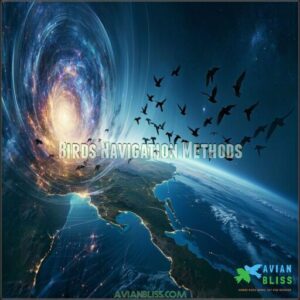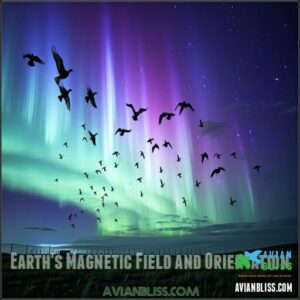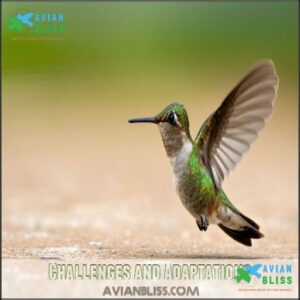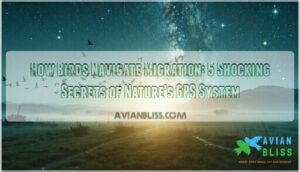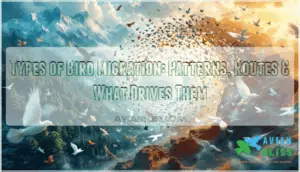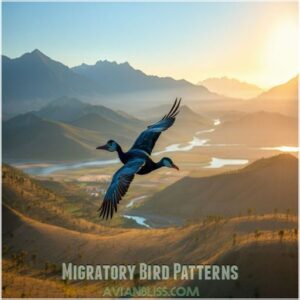This site is supported by our readers. We may earn a commission, at no cost to you, if you purchase through links.
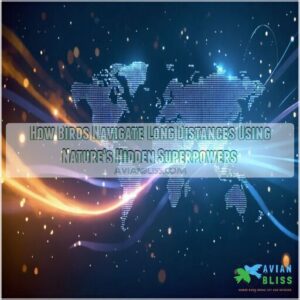 Birds have an incredible knack for traversing long distances, relying on a mix of natural tools that seem almost like superpowers.
Birds have an incredible knack for traversing long distances, relying on a mix of natural tools that seem almost like superpowers.
They use Earth’s magnetic field, thanks to special proteins called cryptochromes in their eyes, which might let them “see” magnetic fields.
On sunny days, they follow the sun’s position as a compass, and at night, they align themselves with star patterns.
Believe it or not, some even use their sense of smell to pinpoint locations, and visual landmarks, like mountains or rivers, also guide them.
It’s like they have a GPS built from millions of years of evolution—no battery needed, relying on natural tools and millions of years of adaptation.
Table Of Contents
- Key Takeaways
- Birds Navigation Methods
- How Birds Navigate Long Distances
- Magnetic Field Navigation
- Celestial Navigation Techniques
- Challenges and Adaptations
- Frequently Asked Questions (FAQs)
- How do migratory birds navigate?
- How do seabirds navigate?
- Are birds long distance migratory?
- How do birds navigate?
- How do birds move?
- How many miles does a bird travel a year?
- Do all bird species migrate during their lifetime?
- How do young birds learn navigation skills?
- What factors determine birds’ migration flight altitude?
- How do birds handle extreme weather during migration?
- Conclusion
Key Takeaways
- Birds use Earth’s magnetic field as a natural compass, with specific proteins in their eyes helping them detect and interpret magnetic signals.
- They rely on visual landmarks like rivers and mountains, memorizing terrain to build mental maps that guide their routes.
- Celestial navigation plays a crucial role, with birds using the Sun, stars, and even the Moon to maintain direction during migration.
- Some birds use their sense of smell to create olfactory maps, decoding atmospheric cues and scent trails to navigate vast distances.
Birds Navigation Methods
You’d be amazed at how birds navigate across vast distances without maps or GPS, relying on a mix of natural superpowers.
From detecting Earth’s magnetic fields to memorizing landmarks, their methods are as precise as they’re fascinating, utilizing a unique blend of innate abilities to achieve this feat with precise navigation.
Sense of Smell
Birds use olfactory navigation to find their way across vast distances, relying on their sharp sense of smell.
Relying on their sharp sense of smell, birds decode atmospheric cues to navigate incredible distances with unmatched precision.
This natural ability helps them decode atmospheric cues, forming an olfactory map of their surroundings. By detecting smell gradients, birds follow odor landscapes to locate breeding or feeding grounds. Supplementing their diet with quality birdseed blends can enhance their overall health and navigational abilities.
Here’s how their olfactory system works:
- Scent mapping lets birds create mental maps of their journeys.
- Chemical signals in the air provide directional guidance.
- Odor trails help them track familiar routes.
- Olfactory cues highlight specific locations like nesting areas.
It’s nature’s extraordinary navigation toolkit!
Visual Cues
Migration becomes easier with landmark recognition. Birds rely on rivers, coastlines, and mountains, building terrain memory for reliable routes.
They also use light polarization and color perception, detecting patterns invisible to us.
| Navigation Technique | Purpose | Advantages |
|---|---|---|
| Landmark Recognition | Guides migration routes | Increases journey accuracy |
| Light Polarization Detection | Helps with orientation | Precise in varying conditions |
| Pattern Identification | Tracks terrain and environment | Enhances long-distance travel |
Their navigation skills may be supported by products aiding recognition.
Their mental maps fuse visual cues with data like polarized light, creating paths as reliable as a sun compass.
Earth’s Magnetic Field
Sensing Earth’s magnetic fields is like holding a natural GPS.
Birds rely on their magnetic compass for precise navigation, even during geomagnetic reversals or magnetic field anomalies.
Here’s how:
- Inclination Compass: Detects the tilt of magnetic fields for orientation.
- Beak Magnetite: Tiny particles sense magnetic field strength and shifts.
- Magnetic Maps: Guides their routes, avoiding human-made interference.
Magnetic navigation evolution shows birds brilliantly utilizing Earth’s geomagnetic field to traverse vast distances.
Landmarks and Piloting
Imagine traveling a road trip using landmarks like rivers, coastlines, or mountains. That’s how birds rely on Terrain Memory and Landmark Reliance for bird navigation.
They memorize geographical landmarks to create mental maps, ensuring Route Familiarity. But Urban Disruption or Deforestation Impact can erase those cues.
| Factor | Role in Navigation | Impact of Loss |
|---|---|---|
| Visual landmarks | Map-building tool | Riskier migration routes |
| Rivers & coastlines | Natural navigation aid | Altered migration paths |
| Familiar routes | Enhances Route Familiarity | Increased disorientation |
| Urban growth | Disrupts Landmarks | Challenges to piloting |
When visual landmarks fade, other tools like magnetic sensing kick in, ensuring birds complete their incredible journeys. Birds also utilize Earth’s magnetic field as a navigation tool.
How Birds Navigate Long Distances

Finding their way across vast distances, birds rely on a mix of navigation strategies.
Genetic programming gives young birds built-in maps, while experienced migrants refine routes over time.
They combine visual landmarks, celestial tools like the Sun and stars, and magnetic fields to stay on course.
Sensory integration, including scent trails, sharpens their homing ability.
Advanced navigation strategies, including Cry4a protein research, reveal the complexity of avian migration.
Birds also rely on olfactory maps to detect familiar scents.
- Genetic programming shapes instinctive migration routes.
- Landmarks and celestial tools aid direction.
- Magnetic fields align paths.
- Sensory integration solidifies navigation.
Magnetic Field Navigation
You mightn’t realize it, but birds can sense Earth’s magnetic field, using it as a built-in compass to guide their epic journeys.
This remarkable ability relies on specialized proteins and even quantum mechanics to detect and interpret magnetic signals.
Radical Pairs and Quantum Spin
Quantum entanglement lets birds sense magnetic fields with cryptochrome proteins in their eyes.
These "radical pairs" form through light-dependent reactions, relying on quantum spin to detect Earth’s magnetic field.
Birds’ magnetic sensitivity depends on radical lifespan and quantum mechanics.
| Feature | Role in Navigation | Dependency |
|---|---|---|
| Cryptochrome Function | Detects magnetic fields | Light-dependent |
| Radical Pairs | Enable magnetic sensing through spin | Quantum mechanics |
| Magnetic Sensitivity | Guides directional accuracy | Radical lifespan |
Cryptochromes and Magnetoreception
Cryptochromes, such as Cry4a, are essential proteins in bird eyes, driving their exceptional vision-based magnetoreception.
By forming radical pairs, these proteins use quantum mechanics to detect Earth’s magnetic field.
This remarkable light sensitivity enables birds to navigate vast distances with pinpoint accuracy.
Disruptions like RF interference hinder this delicate process, revealing how quantum biology intricately guides bird migration through their innate magnetic vision.
These proteins are fundamental for avian magnetic sensing capabilities.
Earth’s Magnetic Field and Orientation
The Earth’s magnetic field acts like an invisible map, guiding bird migration with astonishing precision.
Birds use a magnetic compass to align with field lines, a process called Magnetic Field Perception.
Magnetic Navigation Evolution has fine-tuned their ability to detect Magnetic Field Strength and avoid Magnetic Field Anomalies.
Open fields also play a role, offering vital habitat diversity for migrating bird species.
Despite challenges like geomagnetic reversals, this avian compass guarantees impeccable bird orientation over vast distances, relying on Magnetic Field Perception.
Magnetite and Biological Magnetism
Birds, like pigeons, navigate using magnetite in their beaks—tiny magnetic particles forming a biological compass.
Tiny magnetite crystals in bird beaks act as a biological compass, guiding their incredible journeys across Earth’s magnetic field with precision.
This crystal alignment detects geomagnetic fields, enabling precise bird magnetic navigation.
Combined with cellular magnetism from cryptochromes, birds possess extreme geomagnetic sensitivity.
Even across oceans, this natural system keeps them on track, highlighting how magnetic reception and magnetite function work together for incredible magnetic field orientation.
Celestial Navigation Techniques
You might be surprised to learn that birds can navigate thousands of miles using the Sun, Moon, and stars as their guides.
By combining these celestial cues with patterns they memorize over time, they guarantee precise journeys even across featureless landscapes like oceans or deserts.
Sun Compass
Migratory birds rely on a sun compass for Solar Navigation when flying during the day.
By tracking the Sun Angle and adjusting through their Circadian Rhythm, they achieve precise orientation.
Even with clouds, Light Polarization offers directional cues.
This natural mastery of Time Compensation guarantees smooth bird migration, blending their internal clock with celestial precision for seamless avian navigation across vast distances.
Star Compass
Imagine the night sky as nature’s GPS for birds during migration.
They’ve mastered nocturnal navigation, relying on star navigation to find their way. Birds memorize stellar patterns as youngsters, treating the North Star like a constant, dependable landmark. With this celestial roadmap, they align their internal compass for precise orientation.
Here’s how star identification aids bird migration:
- The North Star provides steady directional cues.
- Stellar patterns act like a map for consistent avian navigation.
- Compass calibration blends star navigation with magnetic field detection.
This combination guarantees birds stay on track, showcasing their evolutionary origins in traversing vast distances accurately.
Moon Navigation
Moon navigation is a remarkable facet of animal navigation.
Birds use lunar alignment and moon phases to guide their nocturnal migrations. The moonlight enhances night vision, helping them stay on course even when landmarks vanish.
Their internal clocks sync with lunar cycles, combining moonlight polarization and celestial navigation with star navigation to traverse long distances.
Here’s a breakdown:
| Feature | Purpose | Benefit |
|---|---|---|
| Lunar Alignment | Directional guidance | Accurate nocturnal travel |
| Moon Phases | Time synchronization | Optimized departure timing |
| Moonlight Polarization | Enhanced visual acuity | Nighttime orientation |
| Lunar Cycles | Clock synchronization | Consistent migrations |
| Celestial Navigation | Combined techniques | Long-distance precision |
The use of lunar cycles and celestial navigation allows birds to migrate with long-distance precision, making their nocturnal travels highly accurate and efficient.
Visual Cues and Mental Maps
Navigation isn’t just about stars or the Moon—it also involves spotting familiar landscapes.
Birds are masters of landmark recognition and terrain memory, blending these skills into seamless route learning. They rely on visual cues like mountains and rivers to build a mental map, guiding them through migration routes. Some birds even use landmark bird feeders as waypoints.
Even in cases of path deviation, their cognitive mapping keeps them on track. This unmatched ability highlights their incredible, almost instinctive navigation skills.
- Rivers weaving across landscapes
- Rugged mountain peaks
- Rolling coastlines hugging the horizon
- Dense forests forming natural markers
- Endless plains guiding the way
Challenges and Adaptations
You might think birds have it easy when traversing the skies, but they face challenges like habitat loss, climate change, and human-made obstacles.
To adapt, they’ve evolved remarkable abilities, from sensing magnetic fields to relying on mental maps of their ever-changing environment, which includes remarkable abilities.
Human Impact on Migration
Human activity reshapes bird migration patterns, often for the worse.
Habitat destruction forces new, risky detours, while migration disruption worsens with manmade obstacles.
Light pollution disorients birds, leading to deadly outcomes, and climate effects skew migration timing.
Here’s how birds suffer:
- Tower collisions, including wind turbines, claim countless lives.
- Cities replace essential resting sites.
- Glass buildings create unseen dangers.
- Lost habitats reduce food availability.
Protecting birds starts with minimizing human impact and preserving habitats to prevent risky detours.
Climate Change and Navigation
Climate change alters migration patterns, creating hurdles birds never faced before.
Rising temperatures, habitat degradation, and extreme weather demand constant adaptation. Shifting migration routes and phenological mismatches leave birds searching for safe havens. Flooded stopovers and shrinking resources weaken their survival chances.
Rising temperatures disrupt food availability.
Here’s a snapshot of climate impacts:
Environmental Change Effect on Birds Navigation Impact
Evolutionary Adaptations and Conservation
Protecting migratory birds means balancing their unique instincts with the environment they rely on.
Genetic navigation and sensory evolution help birds adapt, but human intervention is pivotal.
Here’s how you can support them:
- Preserve habitats for feeding and resting.
- Limit hunting and predation risks.
- Track migratory behavior with technology.
- Protect navigation mechanisms from urbanization.
- Support environmental conservation projects globally.
Insights Into Biological Sensing and Technology
Bird navigation research reveals fascinating breakthroughs in sensory integration and neural processing.
Birds use bio-inspired sensors, like their internal compasses powered by quantum biology, to detect Earth’s magnetic fields.
These navigation techniques inspire technological mimicry in fields like precise drone routing.
Imagine this remarkable connection:
| Concept | Function | Innovation |
|---|---|---|
| Bio-inspired sensors | Magnetic field detection | Navigation systems |
| Quantum biology | Magnetic compass functionality | Advanced navigation tools |
| Sensory integration | Process multiple environmental cues | Smart sensing technologies |
| Neural processing | Link sensory inputs and action | AI development |
| Bird senses | Guide migration trails | Robotic guidance systems |
Frequently Asked Questions (FAQs)
How do migratory birds navigate?
Nearly 20% of bird species migrate, guided by the Sun, stars, magnetic fields, and landmarks.
They combine celestial and magnetic navigation with mental maps, adapting through experience to overcome landscapes and long-distance challenges, using magnetic fields as part of their navigation.
How do seabirds navigate?
Seabirds rely on the Sun, stars, and Earth’s magnetic fields to navigate vast oceans.
They combine these cues with wind patterns, mental maps of feeding areas, and smells, ensuring they find their way back successfully.
Are birds long distance migratory?
About 20% of the world’s 10,000 bird species migrate long distances, traveling up to 50,000 miles annually.
They chase better food, safer nesting, and ideal climates, demonstrating incredible endurance and navigation skills during their journeys.
How do birds navigate?
To navigate, birds use a mix of visual landmarks, the Sun, stars, and Earth’s magnetic field.
Some even "see" magnetic fields, and their internal compass and instinct guide them through remarkable, long-distance journeys every year, using their ability to navigate with the magnetic field.
How do birds move?
Birds move with precision, combining wingbeats and aerodynamic mastery to soar, glide, or hover.
Using their body shape, muscle strength, and air currents, they adapt to habitats, crossing mountains or oceans like nature’s expert aviators.
How many miles does a bird travel a year?
Birds can travel anywhere from a few hundred miles to over 50,000 miles annually, depending on their species.
Arctic Terns, for example, cover an incredible distance during their migration, equivalent to circling the globe.
Do all bird species migrate during their lifetime?
Not every bird migrates.
While about 20% of bird species travel long distances annually, many stay put, thriving in stable climates year-round.
Some birds only migrate short distances, adjusting to seasonal food and habitat changes. Complete concepts
How do young birds learn navigation skills?
Young birds rely on instinct and genetic programming for their first migration, like a built-in GPS.
Over time, experience refines their routes using environmental cues, such as landmarks, celestial navigation, and even Earth’s magnetic fields.
What factors determine birds’ migration flight altitude?
Flying thousands of miles isn’t carefree; altitude choices hinge on weather, oxygen levels, and wind patterns.
Birds climb higher for strong tailwinds or safety, while avoiding predators, turbulence, and harsh conditions that threaten their survival.
How do birds handle extreme weather during migration?
During migration, birds use instincts and weather cues to adapt, flying around storms or seeking shelter.
They avoid extreme winds, conserve energy by gliding, and rely on fat reserves to survive harsh conditions mid-journey, using their instincts to guide them through these challenging situations with extreme winds.
Conclusion
Mastering the art of navigation, birds rely on Earth’s magnetic field, celestial patterns, visual landmarks, and even their sense of smell to traverse vast distances.
Their ability to integrate these natural tools into a precise internal GPS showcases millions of years of adaptation.
Whether following the sun, interpreting star maps, or sensing magnetic fields, birds possess an extraordinary blend of instinct and biology.
Their techniques in how birds navigate long distances continue to inspire science and deepen our understanding of nature’s wonders.
- http://www.nbb.cornell.edu/neurobio/emlen/Misc%20Info/research_accomp.html
- http://oersted.com/helmholtz_coils_1.shtml
- https://www.youtube.com/watch?v=DLfV8P5f7o8
- https://en.wikipedia.org/wiki/Bird_migration
- http://web.archive.org/web/20220509011715/https://www.nationalgeographic.org/media/how-do-birds-navigate/

